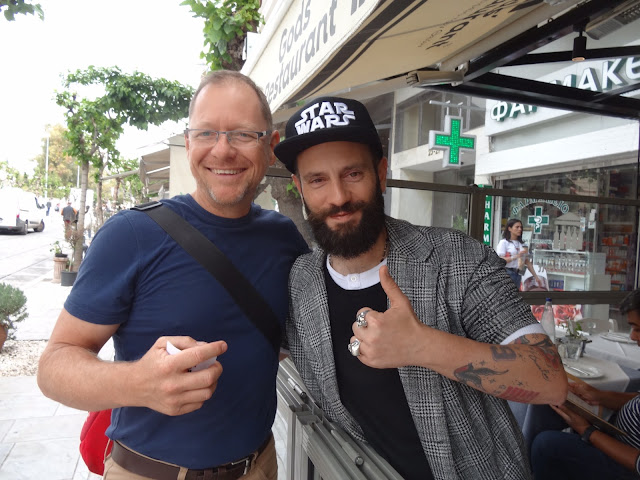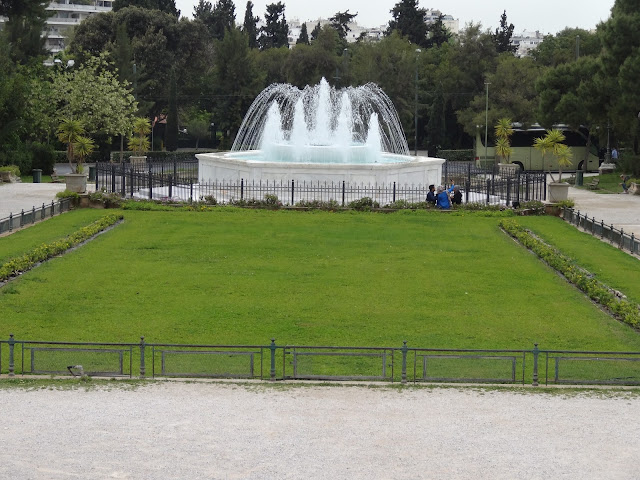And another Athens museum!
 |
| Reminded me a bit of someone I love (but is most likely Sauromates II, King of the Kimmerian Bosporus from 2 AD) |
I know, we’re fairly pushing the museums, but it was worth it. This morning we headed just up the street to the Acropolis Museum. We got going relatively early, and were thankful we did, as the crowds were minimal at that time and we were able to enjoy browsing “jostle-free” through this museum (but they were starting to pour in as we left).
The museum was founded to exhibit all the significant finds from the “sacred rock” and its foothills, and is new and modern, being only 10 years old. The architectural form of the museum maintains visual contact with the monuments of the Acropolis, and is designed to exhibit the Parthenon sculptures in their entirety and displayed as they would have been originally located on the site. The building is also adapted to accommodate the archeological excavation that extends across its foundations, and that can be seen through glass flooring at various locations - the base is supported by more than 100 concrete pillars that shelter the excavation below.
Inside the Parthenon Gallery, a rectangular, solid concrete core was built to the same dimensions and orientation as the Parthenon, and was specially designed to receive and display the entire temple frieze, including the two pediments on the east and west sides of the temple. You can walk around the display and view the temple frieze as would have once been possible when it was first built. It’s pretty impressive.
The gallery also has great views of the Acropolis, the surrounding historic hills and the city of Athens.
The museum’s exhibits tell the story of the Acropolis site, and the buildings that have been erected upon it, not only the current ones, but the original “pre-Parthenon” temple as well. It has a complex and chequered past, including discovery of many artefacts from the Acropolis slopes, and the pillaging and plunder of the amazing sculptures, statues and friezes by various other nations.
 |
| How’s this for a money box? Pop your coins through the hold in the top, then good luck getting the lid off when it’s time to spend!! |
Some of the exhibits were “strictly no photos”. We asked one of the staff what the reason was for this, and her response was “because of the colour of the statues, it makes them fade”. Umm, I’d understand this when it comes to flash photography, which is generally forbidden in most museums, but clearly someone hasn’t done their homework about how non-flash photography works. I suspect the reason may be something other than this, but I can’t for the life of me think what that might be.
 |
| Lion head water spout (on the right.......) |
Another part of the museum displays a series of works that were created after the construction of the Parthenon, namely the Propylaia, the temple of Athena Nike, and the Erechtheion. There are some multimedia displays that are fascinating and tell the stories of the many iterations of the Parthenon, from ancient temple to the goddess Athena, to a Catholic Church in the 5th century AD, and later a mosque under Turkish rule. In 1687 it was bombed and largely destroyed, and the current restoration has been ongoing since 1974.
Another presentation described the sad story of the pillaging that followed in the early 1800s, most notably by British peer Thomas Bruce, Lord Elgin, notorious for his arrogant removal of about half of the sculptures (significant bribery involved), which he shipped to England and later sold to the British Museum for 35,000 pounds. Now known as the “Elgin Marbles”, they are displayed in the Duveen Gallery of that museum (but pretty sure Greece would probably like them back).
One of the fun parts of the museum was seeing an amazing Lego reconstruction of the Acropolis site. Built by an Australian, and donated by the University of Sydney’s Nicholson Museum, the display has a number of quirky additions, such as Sigmund Freud, who famously stood on the Acropolis for the first time in 1904 and proclaimed “So this really does exist, just as we learned at school”, Australia’s “most wanted” Tony Mokbel being arrested in Athens in 2007, complete with a really bad wig, Lord Elgin overseeing removal of sculptures from the Parthenon in 1801, Elton John live in concert in the ancient Odeon of Herodes Atticus when he performed in September 2000, a mobile Souvlaki van complete with hungry tourists, a 5th century BC performance of Sophocles’ play “Oedipus Rex” in the Theatre of Dionysos (complete with final bloody stabbing scene), and Hungarian Nikolska dancing semi-naked at the Parthenon in 1929, next to Melina Mercouri, great actress, politician and champion of Greek cultures (however as Melina was only born in 1920 it’s unlikely these would have happened at the same time)!
We had a chat with a restaurant owner in nearby Makrigianni Street after our morning of solid museum-ing, and asked him if he felt it was sad that so much looting had taken place over the years. He agreed, but said that he thought the saddest aspect of the Parthenon’s history was that the Turks had smashed the faces off many of the statues during their time of ruling in Greece. He asked us if we’d been to the Archeological Museum and whether we’d seen the Antikythera Mechanism! We said we had, and asked him if he knew of the Lego reconstruction. He didn’t! We encouraged him to look it up on YouTube!
We met another restaurant owner, Nikos, a little further down the street, who wanted to chat so he could air his considerable knowledge of Australia, particularly AFL! He told us that most older Greeks in Australia follow Collingwood, but the younger ones follow Carlton. He also knew about Perth Glory and the West Coast Eagles, “rollie” cigarettes, “mate” and “cobber” and took great delight in using his Australian-isms with us. But he didn’t know about Vegemite, so we enlightened him and urged him to look it up on Google!
Hanging out with my husband in Athens inevitably results in funny and interesting conversations with locals. A little later he started chatting with Kristina, who runs a souvenir shop right next door to our apartment. He went out for bread and butter, and over an hour later he came back empty-handed, but having had a great conversation about Greek Orthodoxy and encouraging Kristina to read the gospel of John. No surprise to me at all.
Our afternoon included one last mighty hike, as we headed north-east towards Lycabettus Hill, for a viewing of the Acropolis (and pretty much everything else) from the highest point in the city. But first, we wandered past Hadrian’s Arch and the Temple of Olympian Zeus - as our tour guide had said a couple of days ago “Why go in when you can see it all from the street?” Exactly!
On we hiked, via the National Garden. I was hoping for a lovely, lush, botanical garden affair, but in all honesty it was a bit disappointing. There were lots of trees getting their new spring green on, but otherwise it looked a bit tired and neglected. I guess, given the current state of the Greek economy, some things would have to go by the wayside, but it was disappointing to see so many weeds and untended garden beds. Still, it was quite a pleasant walk, there were a couple of nice statues, some very cute tortoises in a pond, and we stopped to admire the Zappeion, a building that looked like it could have been the governor’s residence, but is actually a hall used for meetings and ceremonies. Nice fountain at the front though.
From the gardens, we continued up through the pretty Kolonaki area, to the base of Lycabettus Hill. We took the plunge and started the climb, and it was quite a climb! About halfway up there is a viewing platform, and we were tempted to call it a view and head on down, but the challenge got the better of us - have I mentioned before about holiday walking challenges?? - and we continued on up to the summit.
 |
| The Parthenon, framed by Aussie Eucalypts! |
Since we’d climbed all that way, we decided it would be as good a spot as any for our last dinner in Athens. Turned out to be a great idea, we had the best moussaka yet, served with a lovely Greek salad and a side of tzatziki. Delicious!
Following our noses (and occasional glimpses of the Acropolis along the way) we made our way back through Kolonaki, then the Plaka area, and finally landed back where we started, glad to put our feet up after all those steps up and down! The little hill we live on in Perth is going to seem incredibly tame by comparison!!


































Comments
Post a Comment